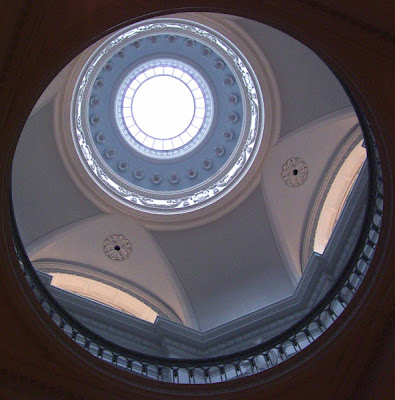The big Georgia O'Keefe exhibit opened today... just in time, because it's raining again. They had signs up all over the place saying "no photography in the galleries" so I took one just to be contrary. I'm not a big fan of her paintings, but there were a lot of really good photographs of O'Keefe taken by her husband Alfred Stieglitz and Todd Webb. I enjoyed those.

Below is the rotunda of the art gallery building which used to be a courthouse.

This wall below is from an exhibit that is being installed. It seemed that just about everybody who walked by stopped to read this wall. It's interesting. If you click on the photo, you can see a version large enough to read.




5 comments:
#14 is interesting, but I can't read all of it.
These Things I Know for Sure:
1. It is a human trait to want to organize things in catagories. Inventing catagories creates an illusion that there is an overriding rationale in the way that the world works.
2. Surfaces that are "easy to clean" also show dirt more. In reality a surface that camouflages dirt is much more practical than one that is easy to clean.
3. Maintenance takes time and energy that can sometimes impede other forms of progress such as learning about new things.
4. All materials ultimately deteriorate and show signs of wear. It is therefore important to create designs that will look better after years of distress.
5. A perfected filing system can sometimes decrease efficiency. For instance, when letters and bills are filled away too quickly, it is easy to forget to respond to them.
6. Many "progressive" designs actually hark back towards the lost idea of nature or a more "original form"
7. Ambiguity in visual design ultimately leads to a greater variety of functions than designs that are functionally fixed.
8. No matter how many options there are it is human nature to always narrow things down to two polar, though inextricably linked choices.
9. The creation of rules is more creative than the destruction of them. Creation demands a higher level of reasoning and draws connections between cause and
effect. The best rules are never stable or permenant but evolve naturally according to context or need.
10. What makes us feel liberated is not living in total freedom, but rather living in a set of limitations that we have created and prescribed for ourselves.
11. Things we think are limiting can ultimately becoming restrictive, and things that we initially think are controlling can sometimes give us a sense of
comfort and security.
12. Ideas seem to gestate the best in a void - when the void is filled it is more difficult to access them. In our consumption-driven society almost all voids are filled, blocking moments of greater clarity and creativity. Things that block voids are called "avoids".
13. Sometimes if you can’t change the situation, you just have to change the way you think about the situation.
14. People are most happy when they are moving towards something not yet attained. (I also wonder if this extends as well to the sensation of physical motion in space. I believe that I am happier when I am in a plane or car because I am moving towards an identifiable and attainable goals.)
- artist Andrea Zittel
1. It is a human trait to want to organize things in catagories. Inventing catagories creates an illusion that there is an overriding rationale in the way that the world works.
2. Contrary people usually get the most out of life.
I like number 9 which seems counter-intuitive to the creation of art or at least to the way we've come to believe how it's created. Creating art my seem like "anything goes" but there are rules to be followed. You're kidding yourself if you think otherwise.
Post a Comment